Extensive Integration Options for Your SAP on Azure: Post-Migration Phase
What remains somewhat outside of the purview is the scope of SAP integration options with Azure. As both products are rather complex, new adopters cannot always determine how to make the best of both.
In this vein, we decided to take another look at the SAP and Azure integration services, opportunities, and, ultimately, benefits. This time around, we’d like to focus on what added-value integrations you should prioritize after executing all other steps on your SAP to Azure migration roadmap.
Azure SAP Integration: What Are the Options Post-Migration?
One of the main benefits of using Azure as a cloud platform for your SAP instances is that it’s already pre-configured to support an array of SAP workloads and apps, thanks to the company’s “Embrace Initiative”. This opportunity, in turn, reduces the time and resources required for implementation, plus multiplies the benefits you are receiving.
Below you may find a list of SAP integration options that we strongly recommend you to consider.
1. SAP and Azure Data Factory
If you look for a comprehensive SAP data integration solution, Azure Data Factory (ADF) has you covered. ADF supports data integration from 70 sources (SAP, non-SAP, on-premises, and cloud-based). Besides, you can benefit from pre-made connectors to enable secure data integration from SAP Business Warehouse (BW), SAP Cloud for Customer, SAP ECC, and SAP HANA.
A connector is a pre-made proxy or wrapper around API that enables your IT teams to connect third-party services and applications to your Azure infrastructure seamlessly.
The business benefits of Azure Data Factory integration with SAP are as follows:
- Cross-platform orchestration for all incoming data;
- Single-pane-of-glass view into all your proprietary data;
- Secure data storage and exchanges, compliant with industry regulations;
- Simplified day-to-day management of data pipelines and supporting infrastructure required for advanced analytics use cases
- Fast time-to-market thanks to pre-made connectors.
2. SAP and Azure Data Catalog
Azure Data Catalog is a self-service platform for data discovery that helps you comb through your records, label them with relevant metadata, annotate, and organize by appropriate criteria. It’s an excellent supporting tool for businesses looking to contextualize existing data and identify new datasets for predictive analytics or other cognitive computing use cases.
Azure Data Catalog can be seamlessly integrated with SAP HANA to assist business users, data scientists, and developers with data discovery, annotation, and management.
The benefits of Azure Data Catalog:
- Reduced data silos and improved data discovery in data lakes;
- Data-driven decision making on all levels due to easier access to insights;
- Competitive, consumption-based pricing;
- Ability to customize and monitor access controls to sensitive information.
3. SAP and Power BI
The benefits of Microsoft Power BI as a real-time, in-memory analytics platform are rather well-identified by now – faster access to data, no speed or memory constraints, lower levels of data fragmentation, rich and user-friendly functionality, well-suited to various line-of-business leaders.
Establishing an SAP integration with Power BI can help you unlock a new quality level of business insights, obtained directly from data hosted in SAP HANA and SAP Business Warehouse. Again, pre-made connectors are available for both products.
This video further illustrates how SAP HANA and Power BI integration works:
The SAP HANA Power BI connector enables real-time access to all data stored in the system so that users can create reports and visualizations powered by the latest insights, rather than a fraction of previously imported data. Some of the handy features supported by the connector are as follows:
- SAP ODBC driver that enhances the user experience;
- DirectQuery and Import options supported;
- In-built support for HANA information models with improved navigation;
- In-built support for SAP HANA Variables and Input Parameters.
Establishing a Power BI connection with SAP BW can also improve your visibility into transactional data to further augment your decision-making. Leveraging OLAP BAPI (OLAP Business Application Programming Interface), the connector establishes quick access to all data and metadata, hosted on SAP BW. Besides, you can also use DirectQuery to connect the two tools, but there are certain technical challenges to that.
4. SAP and Azure Analysis Services
Azure Analysis Services (AAS) enables you to build a master semantic layer sitting on top of all your data sources. In essence, it acts as a single source of truth for all your other BI models, created by business users with Power BI or Power Apps. Providing self-service access to data and guided discovery, AAS empowers your teams to distill insights from large datasets faster. This service also eliminates the need for extra data manipulations (cleansing, preparation, modeling, etc.)
AAS integrates with SAP HANA and SAP BW as data sources. One of the definite benefits here is that AAS can process much higher volumes of data, originating from a multitude of sources, in real-time when compared to Power BI. Also, it hardens the security of your data analytics programs.
Recently, Infopulse helped one global company build a new SAP HANA data warehouse on Microsoft Azure and configured it to ensure near real-time data availability. Post-migration, the average report generation time decreased from 15 days to 10 minutes. You can learn about other gained Azure cloud benefits from the full case study.
5. SAP and Power Apps Integration
Power Apps is a handy low-code platform that has already won over both professional and citizen developers. With drag & drop front-end development functionality, pre-made integrators, and reusable code snippets, Power Apps significantly reduces the development time and costs for business apps.
In January 2020, Microsoft announced that they were launching a new SAP process integration option for Power Apps, enabling users to build automated flows and business apps that were connected to SAP ECC or SAP S/4HANA.
Up for general availability since September 2020, the new connector provides read-only access to SAP data that you can leverage to augment a variety of your apps. Some of the sample use cases include:
- E-inspection apps that provide immediate access to compliance requirements and allow direct reporting on them;
- Inventory management applications allowing master product details look-up and order status verifications;
- Predictive applications that use real-time SAP data to provide demand, inventory forecasting insights.
6. SAP and Dynamics 365
CRM and ERP systems stand in the mortar of all enterprise operations. Enabling instant data sync between SAP ERP and Dynamics 365 Field Service is among the other major business benefits of Microsoft Azure.
To deliver superior service levels to your end-customers, you can link Dynamics 365 Field Service with SAP C/4HANA or SAP S/4HANA to streamline service management and work scheduling.
By consolidating data from two systems, you can also pursue another transformative initiative – roll out predictive maintenance services, powered by ML-based anomaly detection. The newer generation of such algorithms can analyze all incoming device management data from connected devices, pair it with extra insights from on-site technicians, along with historical trends data to deliver highly accurate predictions on industrial equipment performance and its state of deterioration.
Predictive maintenance solutions reduce the need for in-person visits, enhance inventory management lifecycle for spare parts, and significantly improve maintenance costs.
7. SAP and Azure Active Directory (AAD)
Information security ranks high on corporate agendas as more operations are moved to the cloud. Azure Active Directory (AAD) is the cornerstone solution for managing access control and configuring respective levels of security for all SAP solutions on Azure. AAD features the latest single sign-on (SSO) protocols that ensure secure access to all Azure services and the SAP applications built on SAP NetWeaver:
With AAD, enterprises can scale their authentication and security policies for all users without adding unnecessary complexities to the process. A good fraction of security incidents results from employee negligence. Azure Active Directory helps effectively balance the need for greater security with user experience.
Some of the key AAD features include the following:
- SSO is based on the user’s email address or another personal identifier. Users can log in to all Azure and SAP products without the need to create separate logins/passes.
- Single point of control for all identity management tasks. Security, access provisioning, and de-provisioning can be performed in a centralized manner.
- Multi-factor authentication can be added as an extra security layer to protect the most sensitive applications and operations.
In case you want to learn more about securing your data and operations on Microsoft Azure, we recommend reading our eBook – Best Practices for Implementing Remote Work Solutions on Microsoft Azure – that further details your options for establishing network security using Azure Firewall and Network Security Groups, as well as advanced security monitoring with Azure Security Center and Azure Sentinel.
To Conclude
The way forward for enterprises is marked by the ability to continuously improve on the operational inefficiencies and eliminate low-value processes with intelligent automation. Microsoft Azure and SAP provide an ever-growing array of SaaS, IaaS, and PaaS solutions that work exceptionally well together. From security and analytics to ITIL management and customer service management, your SAP data can be utilized better with Microsoft Azure.
Contact Infopulse SAP specialists to receive personalized consultation on the optimal SAP integration methods and solutions for your business. As a certified consulting and development partner to Microsoft and SAP with extensive experience in SAP products, we use our deep product knowledge and technical know-how to help enterprises unlock more value from their investments in both platforms.

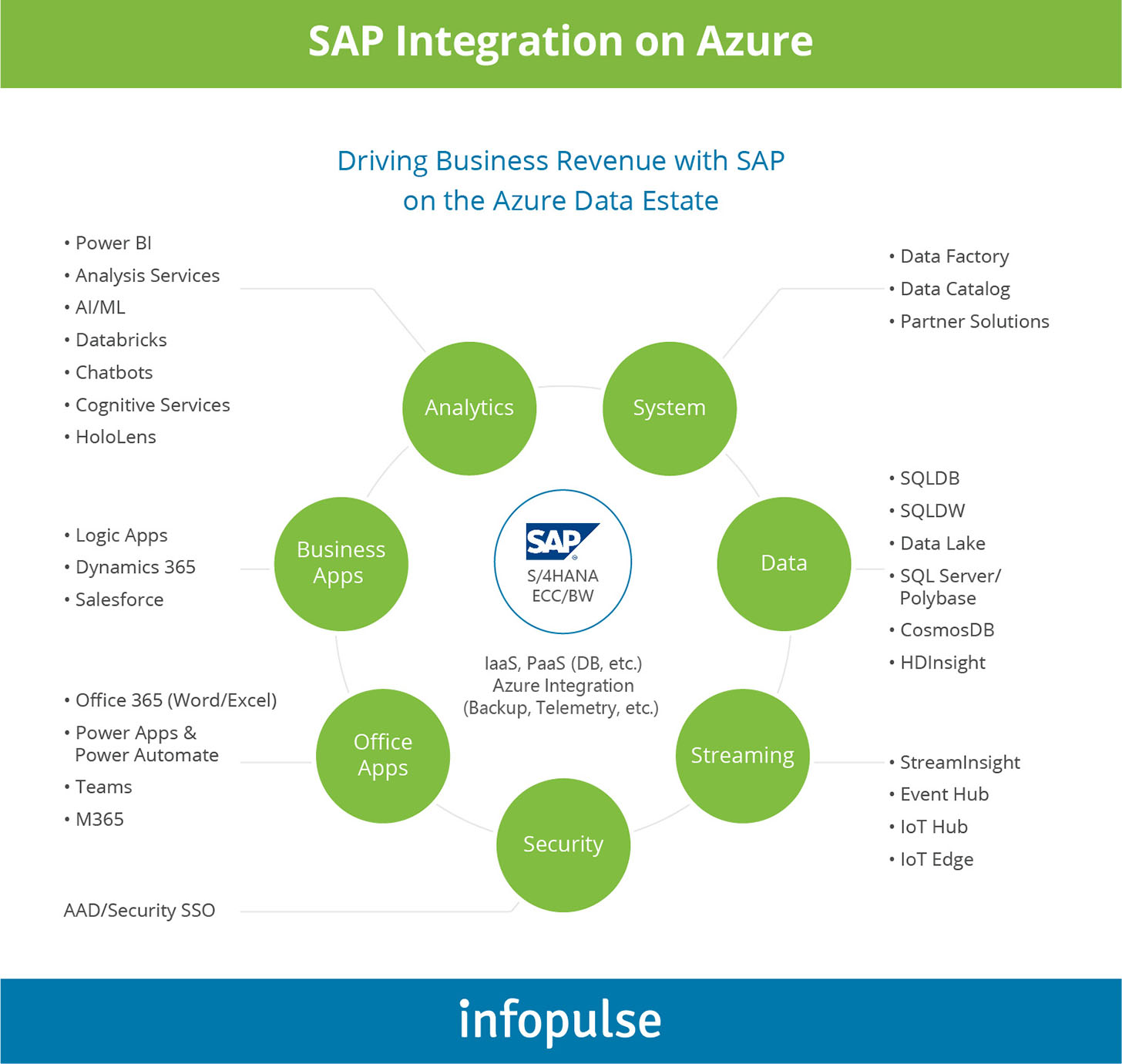
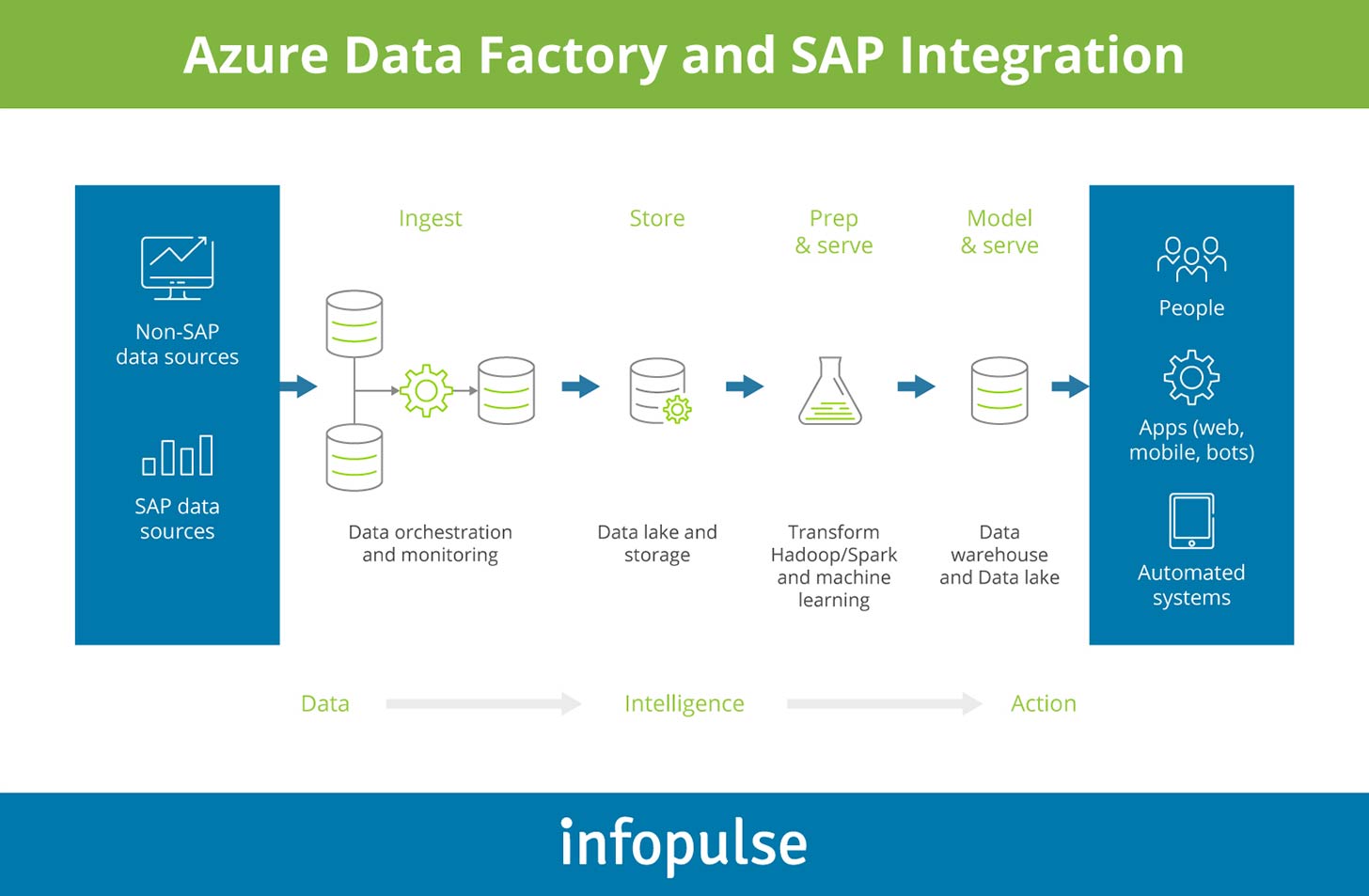
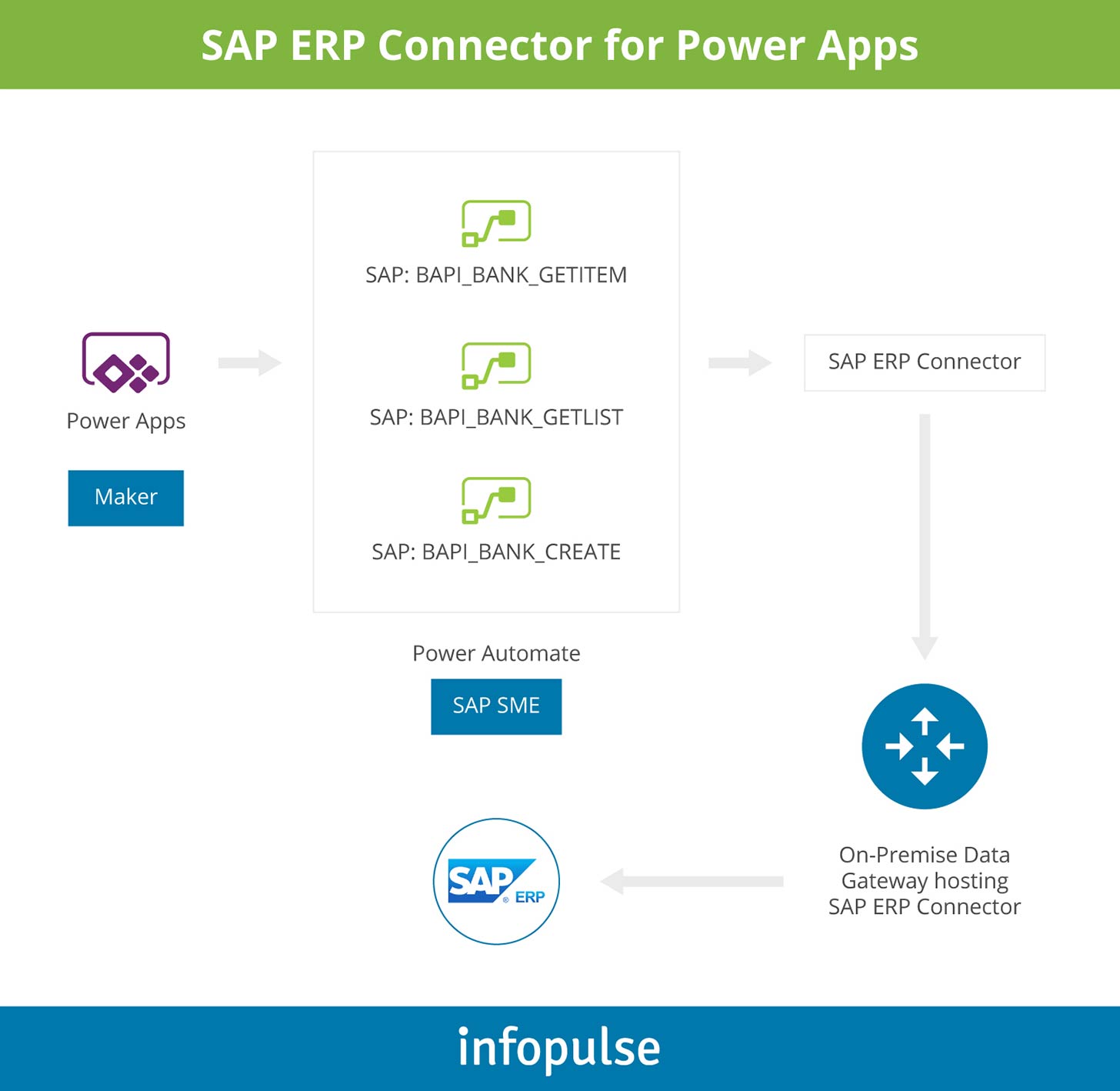
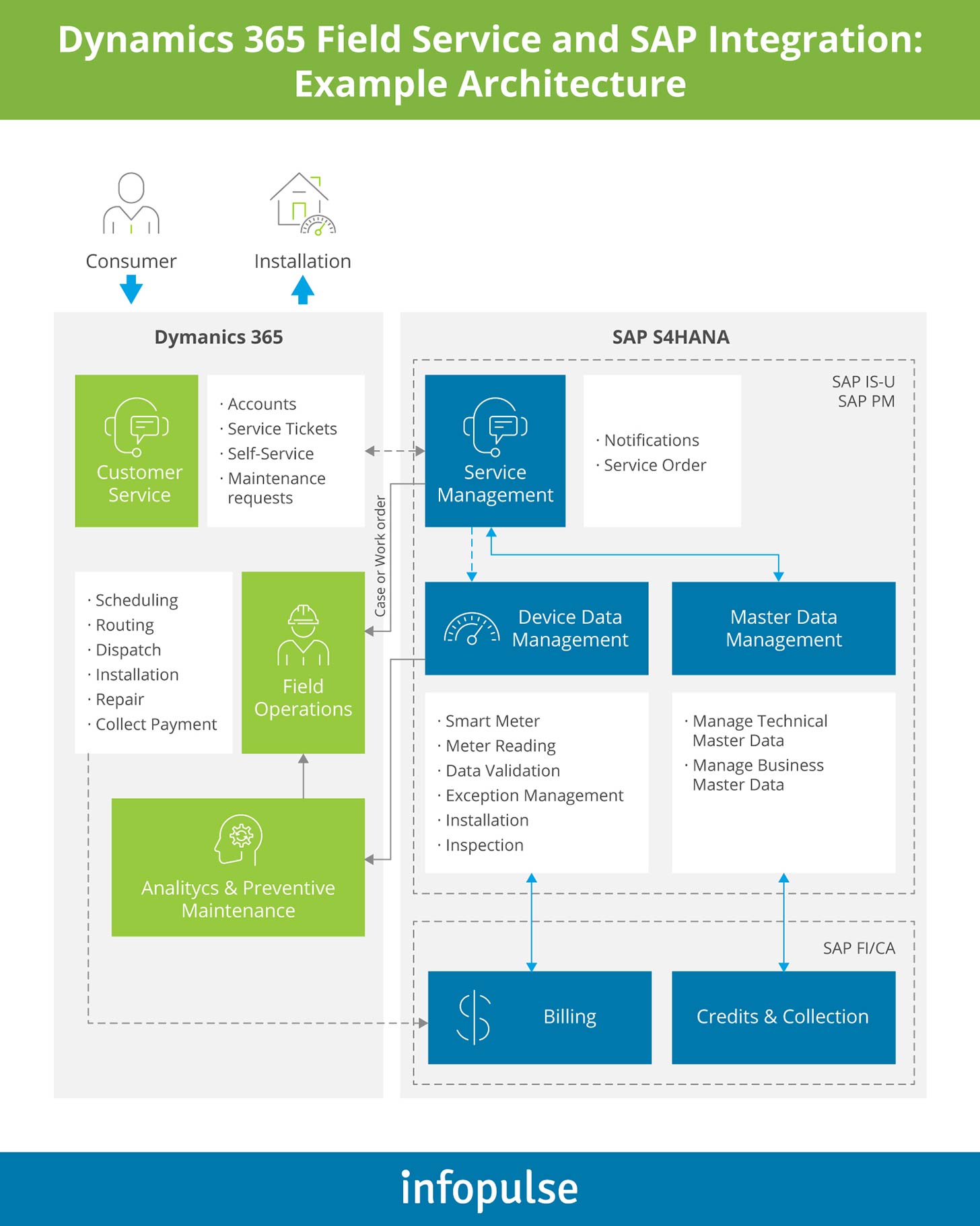
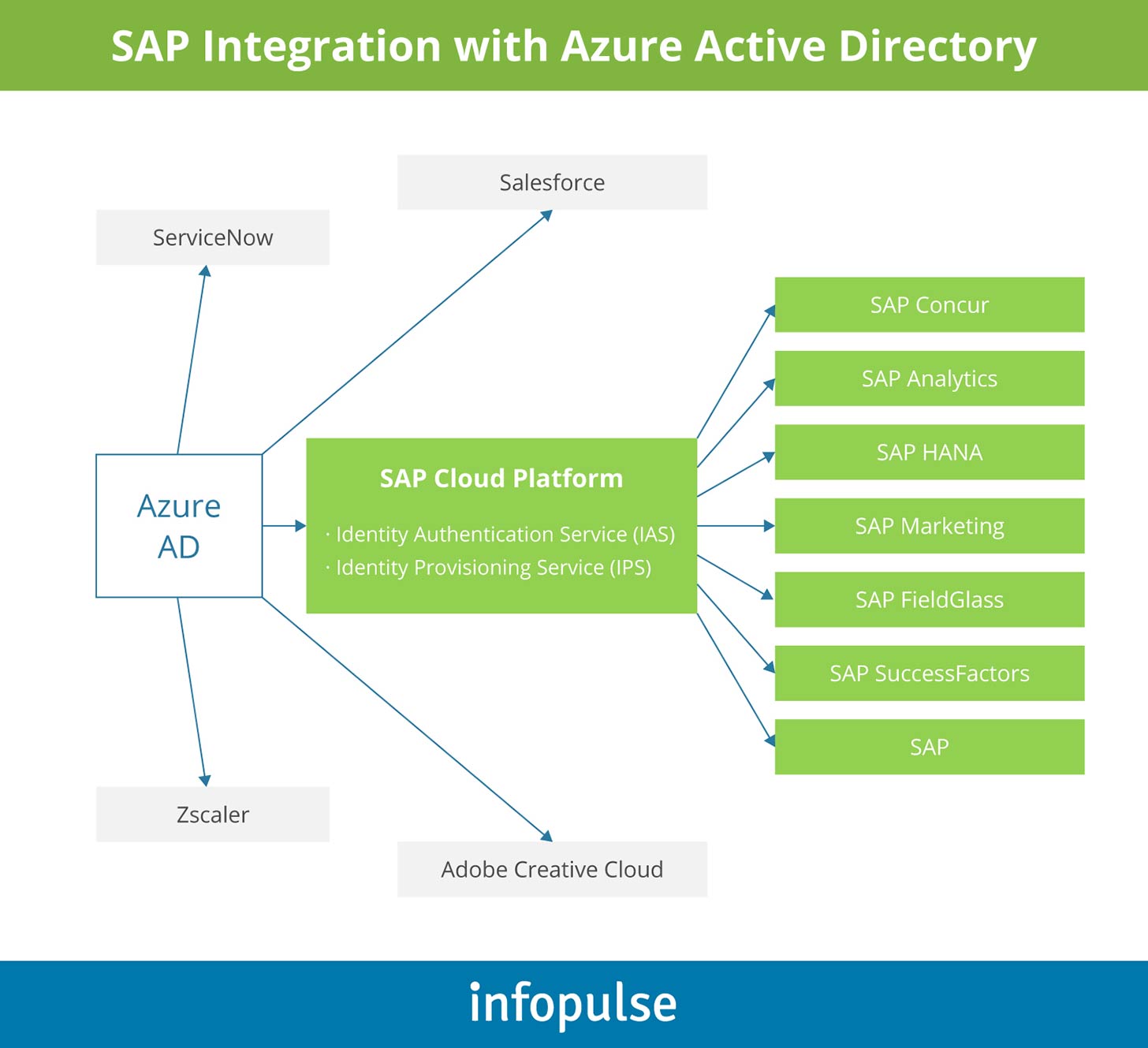

![Power Apps Licensing Guide [thumbnail]](/uploads/media/thumbnail-280x222-power-apps-licensing-guide.webp)
![Cloud-Native for Banking [thumbnail]](/uploads/media/cloud-native-solutions-for-banking_280x222.webp)
![Generative AI and Power BI [thumbnail]](/uploads/media/thumbnail-280x222-generative-AI-and-Power-BI-a-powerful.webp)
![AI for Risk Assessment in Insurance [thumbnail]](/uploads/media/aI-enabled-risk-assessment_280x222.webp)
![How to Build Enterprise Software Systems [thumbnail]](/uploads/media/thumbnail-280x222-how-to-build-enterprise-software-systems.webp)
![Super Apps Review [thumbnail]](/uploads/media/thumbnail-280x222-introducing-Super-App-a-Better-Approach-to-All-in-One-Experience.webp)
![ServiceNow and Third-Party Integrations [thumbnail]](/uploads/media/thumbnail-280x222-how-to-integrate-service-now-and-third-party-systems.webp)
![SAP Service Insight [thumbnail]](/uploads/media/Service Insight-Infopulse-SAP-Vendor-280x222.webp)
![Carbon Management Challenges and Solutions [thumbnail]](/uploads/media/thumbnail-280x222-carbon-management-3-challenges-and-solutions-to-prepare-for-a-sustainable-future.webp)
![White-label Mobile Banking App [Thumbnail]](/uploads/media/thumbnail-280x222-white-label-mobile-banking-application.webp)